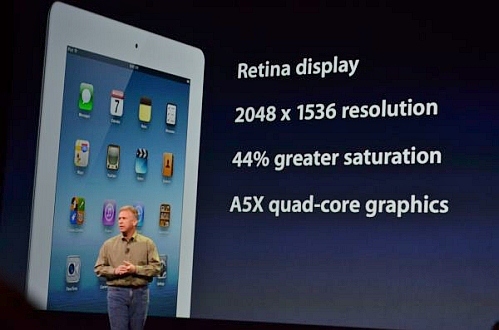Following month after month of ardent speculation surrounding Apple's impending third-generation iPad and the flagrant fanboyism that defines Apple as a corporation, many technology enthusiasts typically reproach the day when the company has to announce a new flagship product. Nevertheless, we are thrilled that as of today, the rumors surrounding the third-generation iPad can finally be put to rest as company executives have just confirmed the device's hardware details on-stage during its media event in San Francisco.
Introducing the third-generation Apple iPad.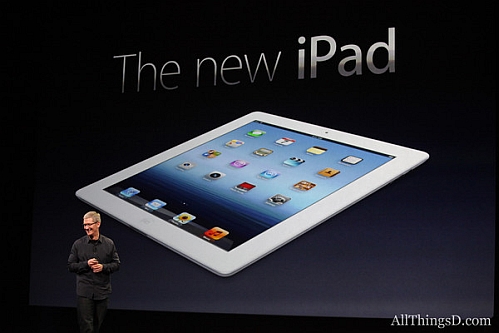
Image source: AllThingsD
Contrary to popular belief, this device is not an "iPad 3." If it were an iPad 3, it would feature a 28nm Apple A6 SoC based on ARM Cortex A15 or equivalent processors. We were ultimately right about the name - it is safe to call this device the "third-generation iPad" as Apple failed to provide it with a proper name during the launch event in San Francisco today. Nevertheless, the new tablet officially features a 28nm Apple A5x SoC with what Apple calls "quad-core graphics" - essentially a dual-core Cortex A9 plus a PowerVR SGX543MP4. While clockspeeds are still unknown, the new SoC provides an upgrade over the SGX543MP2 used in the iPad 2.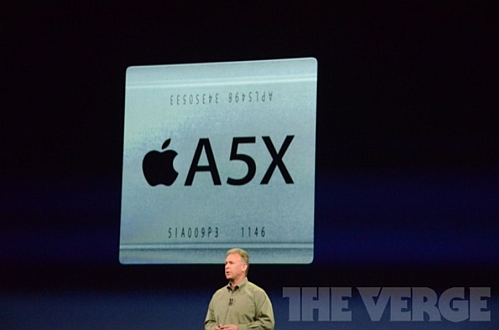
Image source: The Verge
Apple claims the new graphics compute power will be responsible for pushing pixels on the 9.7-inch, 2048 x 1536 resolution Retina Display and also handling duties like stabilization for the new iPad's camera.
"It has a 9.7-inch display with 3.1 million pixels with a resolution of 2048 by 1536 pixels," said Phil Schiller, Senior Vice President of Worldwide Marketing at Apple. "That’s 1 million more pixels than an HDTV, and 264 pixels-per-inch. That is enough to call it a Retina Display." The iPhone 4, fourth-gen iPod touch and iPhone 4S have retina resolution when held at 10 inches from face. The same is true of the third-generation iPad, when held at 15 inches away or even somewhat closer.

Image source: AllThingsD
The third-generation iPad also features a much-anticipated 4G LTE radio. The company will offer two separate LTE models of the device in the United States - one for support on Verizon's 4G LTE network and one for AT&T's 4G LTE network. As for the rest of the world, there will be LTE world-ready devices for Rogers, Bell and Telus. Apple claims that its device can provide up to 73Mbps LTE throughput compared to 21Mbps on 3.5G HSPA+ radios. Nevertheless, the tablet will also support personal hotspot mode, similar to what's already enabled on the iPhone with supported carriers. 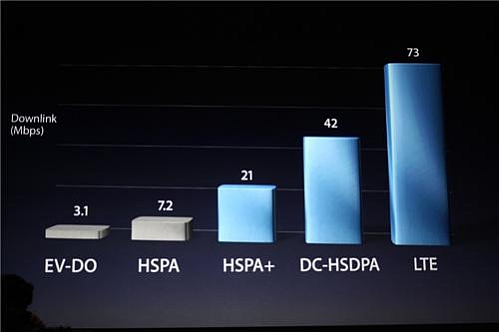
Indeed, Apple's new tablet does feature a redesigned 5-megapixel camera with hardware specifications very similar to the upgraded camera found in the iPhone 4S (only 5-megapixel instead of 8-megapixel). It has a 5-element lens with backside illumination, a Hybrid IR filter, a proprietary Apple Image Signal Processor (ISP), 1080p video recording and the all-important image stabilization feature.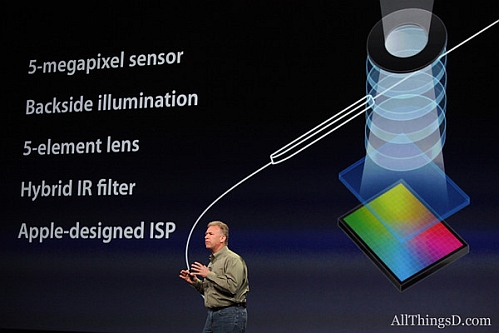
The final hardware specification announced during the iPad Launch Event in San Francisco was the new device's size and weight. As we confirmed in our previous report, the new device is officially slightly thicker than the iPad 2 at 9.4mm thickness and will weigh in at 1.4 pounds (0.64kg).
Apple intends to launch the third-generation iPad with the same respective price points as its predecessor - $499 for the 16GB model, $599 for the 32GB model and $699 for the 64GB model. In addition, the 4G LTE-enabled models will all cost an extra $130 on top of those price points - $629 for the 16GB LTE model, $729 for the 32GB LTE model and $829 for the 64GB LTE model.
Regardless of the particularities of Apple's third-generation iPad announcement today, there are still a few final specifications that we are waiting to hear - memory capacity (DRAM), Lithium-Ion Polymer battery capacity (mAh), A5x SoC clockspeeds and the actual name of the device.
The third-generation iPad will launch next Friday, March 16, 2012.


